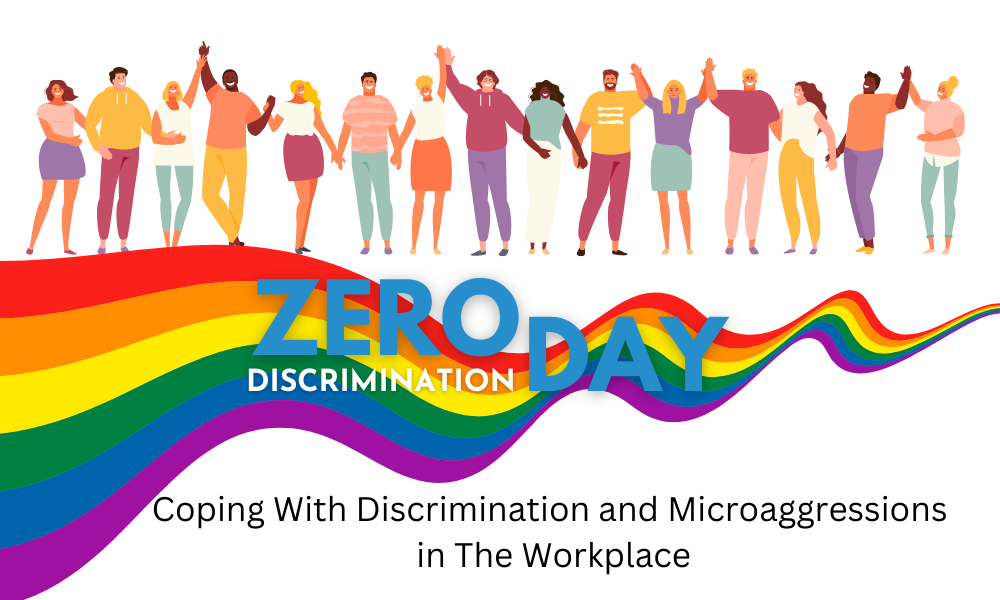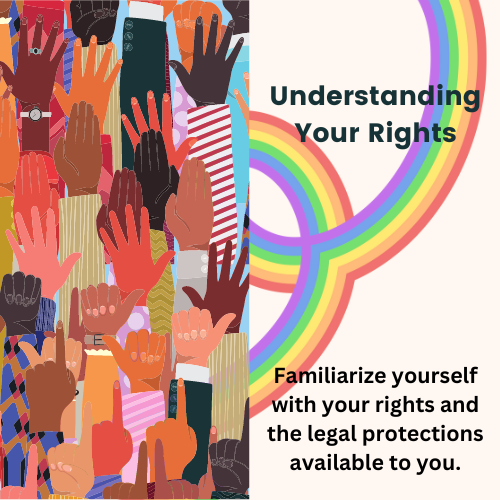The premiere networking group for queer business owners and professionals in the greater St. Louis area.
Coping With Discrimination and Microaggressions in The Workplace
Discrimination and microaggressions in the workplace can significantly impact an individual's mental health, job satisfaction, and overall well-being. For marginalized groups, including LGBTQ+ professionals, these challenges can be particularly pronounced. Here’s a comprehensive guide on how to handle and cope with discrimination or microaggressions in the workplace.
Recognize Discrimination and Microaggressions
Understanding what constitutes discrimination and microaggressions is the first step in addressing them. Discrimination involves unfair treatment based on race, gender, sexual orientation, religion, or other protected characteristics. Microaggressions are those subtle, often unintentional comments or actions that convey prejudiced attitudes toward marginalized groups. Think of comments like, “You don’t look gay,” or assuming someone’s pronouns — classic cases of people’s ignorance showing through.
- Discrimination: Unfair treatment based on race, gender, sexual orientation, religion, or other protected characteristics.
- Microaggressions: Subtle, often unintentional, comments or actions that convey prejudiced attitudes toward marginalized groups.
- Examples: Comments like “You don’t look gay,” assuming someone’s pronouns, or questioning someone’s capabilities based on their identity.
Document Incidents
Keeping detailed records of discriminatory incidents is crucial for addressing and reporting them. Maintain an incident log with the date, time, location, individuals involved, and a detailed description of each incident. Note any witnesses who observed the incident and record how it affected you emotionally and professionally. It’s like keeping a diary, but with more HR jargon and fewer teenage crushes.
- Incident Log: Document the date, time, location, individuals involved, and a detailed description of each incident.
- Witnesses: Note any witnesses who observed the incident.
- Emotional Impact: Record how the incident affected you emotionally and professionally.
Understand Your Rights
Familiarize yourself with your rights and the legal protections available to you. Federal laws like Title VII of the Civil Rights Act and the Americans with Disabilities Act (ADA) prohibit workplace discrimination. Some states and localities offer additional protections for LGBTQ+ individuals. Review your company’s anti-discrimination policies and reporting procedures. Knowing your rights is like having a superpower — you’re ready to face any villainous discrimination that comes your way.
- Federal Laws: Title VII of the Civil Rights Act, Americans with Disabilities Act (ADA), and other federal laws prohibit workplace discrimination.
- State and Local Laws: Some states and localities have additional protections for LGBTQ+ individuals.
- Company Policies: Review your company’s anti-discrimination policies and reporting procedures.
Report the Incident
Reporting incidents of discrimination or microaggressions is a vital step in addressing them. Use your company’s formal reporting channels, such as HR or an anonymous hotline, and submit a formal written complaint detailing the incidents. If internal reporting doesn’t resolve the issue, consider filing a complaint with the EEOC or state agencies. It’s like being the hero in your own workplace drama, standing up for what’s right.
- Internal Channels: Use your company’s formal reporting channels, such as HR or an anonymous hotline.
- Formal Complaint: Submit a formal written complaint detailing the incidents.
- External Agencies: If internal reporting does not resolve the issue, consider filing a complaint with the EEOC or state agencies.
Seek Support
Having a strong support network can provide emotional and practical assistance. Join Employee Resource Groups (ERGs) focused on LGBTQ+ issues for peer support and advocacy. Identify mentors and allies within your organization who can offer guidance and support. Engage with external professional networks and LGBTQ+ organizations. Think of it as building your own squad of superheroes, all ready to back you up.
- Employee Resource Groups (ERGs): Join ERGs focused on LGBTQ+ issues for peer support and advocacy.
- Mentors and Allies: Identify mentors and allies within your organization who can offer guidance and support.
- Professional Networks: Engage with external professional networks and LGBTQ+ organizations.
Develop Coping Strategies
Implementing effective coping strategies is essential for managing stress and maintaining well-being. Engage in self-care activities like exercise, meditation, and hobbies. Seek therapy or counseling to process your experiences and develop coping strategies. Practice stress management techniques such as deep breathing, mindfulness, and progressive muscle relaxation. Remember, even superheroes need a day off to recharge and regroup.
- Self-Care: Engage in self-care activities such as exercise, meditation and hobbies.
- Therapy and Counseling: Seek therapy or counseling to process your experiences and develop coping strategies.
- Stress Management Techniques: Practice stress management techniques such as deep breathing, mindfulness and progressive muscle relaxation
Advocate for Change
Promoting systemic change can help create a more inclusive workplace. Advocate for regular reviews and updates of anti-discrimination policies and promote the implementation of comprehensive diversity and inclusion training programs. Encourage initiatives that foster an inclusive workplace culture, such as using inclusive language and celebrating diversity through events. It’s all about making your workplace as inclusive as the best Pride parade — minus the glitter cleanup.
- Policy Review: Advocate for regular reviews and updates of anti-discrimination policies.
- Diversity Training: Promote the implementation of comprehensive diversity and inclusion training programs.
- Inclusive Culture: Encourage initiatives that foster an inclusive workplace culture, such as inclusive language and events celebrating diversity.
Learn from Resources
Continuous education can empower you to handle discrimination more effectively. Read books on discrimination and microaggressions, attend workshops and webinars focused on diversity and inclusion, and utilize online resources and toolkits from organizations like the Human Rights Campaign and Out & Equal. Consider it your ongoing education in Fabulousness and Resilience.
- Books: Read books on discrimination and microaggressions, such as "Microaggressions in Everyday Life" by Derald Wing Sue.
- Workshops and Webinars: Attend workshops and webinars focused on diversity and inclusion.
- Online Resources: Utilize online resources and toolkits from organizations like the Human Rights Campaign and Out & Equal.
Build Resilience
Building resilience can help you navigate and recover from discrimination and microaggressions in the workplace. Cultivate positive relationships that provide support and encouragement, develop adaptability skills to manage changes and challenges effectively, and focus on areas where you have control to take proactive steps to improve your situation. Building resilience is like working out — strengthening your mental muscles to face whatever comes your way.
- Positive Relationships: Cultivate positive relationships that provide support and encouragement.
- Adaptability: Develop adaptability skills to manage changes and challenges effectively.
- Empowerment: Focus on areas where you have control and take proactive steps to improve your situation.
Reflect and Grow
Use your experiences as opportunities for personal and professional growth. Engage in reflective practices like journaling to process your experiences and emotions. Identify skills and strengths you’ve developed through overcoming challenges, and share your experiences and insights to empower and support others facing similar challenges. It’s about turning adversity into strength and becoming the role model you needed when you first faced these issues.
- Reflective Practices: Engage in reflective practices such as journaling to process your experiences and emotions.
- Skill Development: Identify skills and strengths that you have developed through overcoming challenges.
- Empower Others: Share your experiences and insights to empower and support others facing similar challenges.
Discrimination and Microaggressions in The Workplace Conclusion and Resources
Coping with discrimination and microaggressions in the workplace requires a combination of awareness, documentation, support, and proactive strategies. By recognizing discrimination, documenting incidents, understanding your rights, reporting the incidents, seeking support, developing coping strategies, advocating for change, continuously educating yourself, building resilience, and using reflective practices, you can effectively handle and cope with these challenges. Implementing these strategies will help you maintain your well-being, foster a more inclusive work environment, and support your personal and professional growth. Stay strong, stay fabulous, and remember — you’ve got this!
Resources:
American Psychological Association: Understanding Microaggressions
▼ Follow us on your favorite social media platforms ▼
Queerprofessionalalliance.com © All rights reserved 2025




















